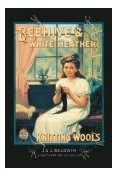
All I have to do is sew it together. I love how it turned out. I prefer the stockingette version because garter makes a pretty bulky version which seems out of proportion for a tiny baby. Not that they can move around so easily -- and do so love to be swaddled. The thinner fabric appeals to me more.
My adjustments1. Because garter stitch is horizontally stretchier than stockingette, I cast on 10% fewer stitches (36) and increased evenly across the last of the 4 garter ridges to achieve the 40 stitches called for.
2. Chain edge stitch for all edges that will not be part of a seam. See the sleeve edge and front edge below.
3. To prevent the sleeve edge's rolling over, knit the last 6 sleeve stitches in garter rows. Begin on the 7th sleeve increase. Of course, the last stitch is the chain edging.
 4.
4. Back of neck. After the 8th and last sleeve increases are completed on both sides, on the next WS row: 1 edge stitch, knit 5, purl 28 , place marker, knit 20, place marker, purl 28, knit 5 , 1 edge stitch. Increase the knit stitches between markers by 1 on each side every second row until there are 26 stitches between markers. On the next row, bind off the center 20 stitches, using a purl bind off so the bind off chain stitching will be on the inside. My own preference -- can be ignored if you don't care about that detail.
 5.
5. Front edges. I used the optional YO (yarnover) increase to make this cute column of holes, (a.k.a. "lace") before a garter ridge of 4 stitches, the last of which is the chain edge stitch. The yarnover is on the RS row and purled on the WS row.
 6.
6. Bottom edges: On the last 2 rows of the front edge increase (39 stitches on needle): RS, knit 34, YO, knit 3, chain edge. WS: Begin bottom garter edge: 1 chain edge,* knit 6 (including the YO), k2tog*. Repeat *xxx* 3 times. There are now 36 stitches for the edge. Continue with chain edge until there are 4 ridges. Bind off as desired. Sew together.
 More Tricks
More Tricks
A. Chain edge stitch for all outside edges because my edges are awful otherwise
B. For garter version: edge increase: with 2 sts left, pick horizontal yarn between sts, leaning left; k1, chain edge
C. Bind off for sleeves. To avoid the gap between the 3 stitch decrease sections. Cast off first set of 3 stitches as usual. For the next 7, k to last stitch, keeping the yarn in back, pick up last stitch as if to knit, place it back on left hand needle, wrap yarn around stitch on left needle and turn the work, pick up wrapped stitch as if to knit, DO NOT KNIT IT, knit next stitch, bring the first, unknitted stitch over the knitted stitch and proceed to next cast off.
D. I figure out how to increase by dividing the number of stitches ultimately desired by one more than the number to add. So, 40 divided by 5 equals 8. That means, every 8 stitches make or increase 1 stitch. This will center the increases, leaving the same number on either side. If the total doesn't divide so tidily, distribute the "carryovers" evenly over the row. For example That is: 42 divided by 5 is 8 with 2 left over. So, decide where in the row to knit 9 (twice) before increasing.
E. I haven't figured out the formula for decreasing but I'll let you know when I do.






















































